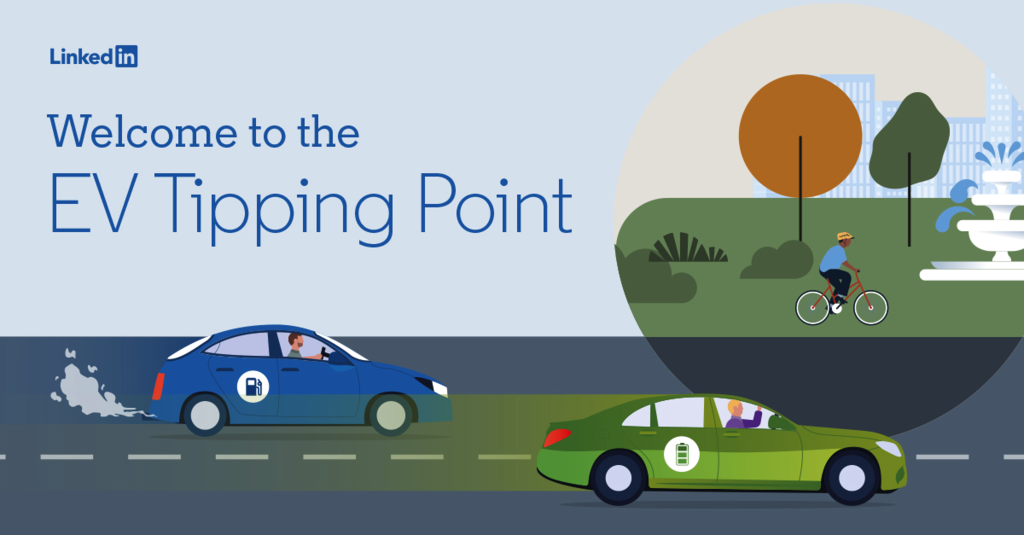Trends, tips, and best practices
Welcome to the EV Tipping Point
The tipping point for a trend or technology is often only visible in the rear-view mirror. It’s with the benefit of hindsight that we get to see the moment when something passed from the ranks of a few influential innovators, grabbed the attention of early adopters and swiftly enter the mass market. This limited view can often leave established brands flat-footed. As Clayton Christensen famously described in The Innovator’s Dilemma, emerging trends aren’t large enough to pivot your entire business model around – until suddenly they are, and it’s too late to do so.
For these reasons, a tipping point that is predictable and visible in advance represents a precious opportunity. And that’s the type of opportunity that’s revealed in The Journey to Electrification 2020, LinkedIn’s latest analysis of the Electric Vehicle (EV) market. It shows that the proportion of LinkedIn members considering an EV purchase has more than trebled in just three years, from 12% in 2017 to 38% today. Over the same period, the proportion of members already owning an EV has increased by 2.6x, reaching 8%.
These steep rises in consideration and ownership reflect a shift already taking place in the auto market. Data from the Society of Motor Manufacturers and Traders (SMMT) shows that EV and Hybrid share of the UK market stands at 12.9%, up from 2.3% in 2018. Last year, the International Energy Agency (IEA) predicted that EVs will represent at least 30% of the global auto market by 2030. It feels like that could prove to be a conservative estimate.
The COVID-19 pandemic has caused widespread disruption in the auto market, with dealerships closed and sales dropping significantly. However, analysis of the data suggests that this sudden stall won’t interrupt EVs’ journey into the mainstream. It may even accelerate it further. SMMT data for April shows sales of all vehicle categories in the UK declining in April – but sales of Battery-powered EVs declined by less than a tenth of other categories. The Tesla Model 3 and Jaguar I-Pace were the most registered models of the month.
Stylish, sustainable and speedy – the new view of EVs
It’s not just the purchase intent data that suggests EV adoption is about to accelerate – there are also important changes in sentiment when it comes to driving electric. When we asked what LinkedIn members most look forward to when it comes to owning an EV, 71% chose the benefits for the environment as one of their top two answers. It’s a response that has almost doubled in popularity over the last two years. Just as significant though, is the growing consensus that drivers don’t have to sacrifice excitement, style or fun to do the right thing by the planet. Over half (53%) mentioned the visual appeal of EVs as a positive, and 50% talked about them running more cost-efficiently. The percentage who chose “good accelerating power” rose from 13% in 2018 to 46% today. It’s this growing consensus that EVs are fun to drive that I believe will be most significant shift in steering them into the mainstream.
Finding the fast lanes for EV adoption
Auto manufacturers have been preparing for such a moment for some time. That’s why around 400 new EV models are set to hit the market between 2020 and 2025. They’ve taken steps to avoid being caught out in the way that Christensen described. However, they’ve still had to draw up their production and launch plans with limited visibility as to where exactly the fast lanes will be for EV growth.
Once again, LinkedIn data provides some important answers. Our Electrification study shows that 10% of LinkedIn members in Europe already own an EV, the highest adoption levels of any region. However India, where 52% of members plan to purchase an EV on the back of already high ownership levels, looks like the largest growth market. It’s closely followed by the Middle East and North Africa (MENA), where 49% report planning a purchase, and Brazil, which currently has one of the lowest levels of EV adoption but matches MENA for purchase intent.
Across these markets, it’s younger drivers who will steer EVs into the mainstream. Current ownership levels may be highest among Baby Boomers (10% of whom drive electric). However, the 45% of Gen Z and 44% of Millennials planning an EV purchase is significantly higher than for both Boomers (28%) and Gen X (39%).
These different generations all show growing interest in broader mobility trends such as driverless cars and Mobility as a Service (MaaS) – but they show the greatest interest of all in driving electric. Engagement with EV-related hashtags on LinkedIn grew 413% in 2019 – that’s over 4x the increase in engagement with hashtags on autonomous vehicles. The future of driving may involve different trends – but every one of these trends will be electrified.
How brands can grow their share of the EV conversation
According to Global Web Index data, brand beats functionality and price when it comes to the factors exerting most influence over which vehicle people buy. The EV market will be no different. Brands can gain share of market by growing their share of voice within the electrification conversation on LinkedIn. In doing so, they can build salience among the early adopters that will push EVs past the tipping point.
LinkedIn conducts white space analysis of engagement with content that helps to identify how different brands are currently positioned in a market. In the case of EVs this analysis shows that no single manufacturer has fully claimed the conversation – yet. There are brands, like Volkswagen, that publish a lot of relevant company updates. There are others (Mercedes-Benz, Land Rover and Tesla) that generate high levels of engagement for the updates that they share. No brand has yet matched consistent ownership of the topic with consistently high engagement.
Similarly, when we analyse engagement for third-party articles mentioning brands in the context of EVs, Tesla generates the lion’s share of the coverage. However, mentions of more traditional auto brands often generate the highest engagement levels. Audiences are interested in hearing more about electrification from the likes of Land Rover, Jaguar and Porsche. And there is real opportunity in meeting that demand.
Owning the EV conversation on LinkedIn means owning the conversation among the early adopters that are crucial for taking electrification mainstream. They are among the most active users of LinkedIn, following 79% more companies, sharing 70% more posts and connected to networks that are 203% larger. They are also among the most responsive audiences when engaged by brand advertising on the platform. Among early adopters, brands that advertise on LinkedIn are 3x as likely to be perceived as professional and intelligent, and 2x as likely to be seen as high-quality and more respectable.
Advanced warning of a tipping point is a precious opportunity for brands. An influential audience interested in hearing more from those brands makes that opportunity more valuable still. It’s time to press the accelerator.
Related articles



